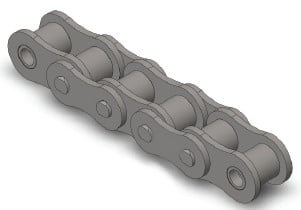Roller chains are one particular in the most productive and price eff ective approaches 
of transmitting electrical power. Successful selection involves following a number of rather uncomplicated ways involving algebraic calculation as well as the utilization of horsepower and support factor tables.
For any given set of drive disorders, there are a number of doable chain/sprocket confi gurations that could successfully operate. The designer hence should be conscious of quite a few basic choice rules that when utilized correctly, assistance stability overall drive functionality and expense. By following the steps outlined on this section designers really should be ready to produce choices that meet the requirements of the drive and are price eff ective.
Basic Roller Chain Drive Principles
? The advisable quantity of teeth for your modest sprocket is 15. The minimal is 9 teeth – smoother operation is obtained with much more teeth.
? The advisable optimum variety of teeth for the significant sprocket is 120. Note that even though far more teeth enables for smoother operation obtaining also lots of teeth prospects to chain jumping off the sprocket following a comparatively tiny quantity of chain elongation as a result of dress in – That is chains having a incredibly large number of teeth accommodate much less put on just before the chain will no longer wrap about them adequately.
? Speed ratios should be seven:one or less (optimum) and not better
than 10:1. For greater ratios the usage of numerous chain reductions is recommended.
? The proposed minimal wrap in the modest sprocket is 120°.
? The proposed center distance among shafts is 30-50 pitches of chain. You will discover two exceptions to this as follows:
1. The center distance needs to be greater compared to the sum from the outside diameters from the driver and driven sprockets to avoid interference.
2. For velocity ratios higher than three:one the center distance shouldn’t be significantly less than the outdoors diameter with the substantial sprocket minus the outdoors diameter in the little sprocket to assure a minimal 120° wrap all-around the modest sprocket.